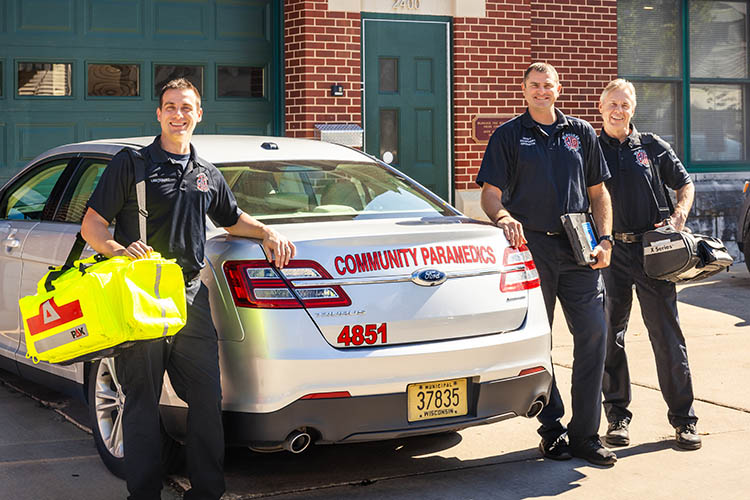Community Paramedics Help Close a Gap in Healthcare
By
Amy Grzyb, who has worked with emergency services for 20 years, sees learning about preventive care and education as part of her job. That’s why she and other emergency responders signed up this summer for a unique program offered through UWM’s School of Nursing.
The Community Paramedic Program trains paramedics and emergency medical technicians how to do preventive and follow-up care after responding to emergencies. “It’s another way we can be of service to our community,” said Grzyb.
The program, which started in 2015, has trained approximately 250 emergency responders as community paramedics, said Kim Litwack, dean of the School of Nursing who established the program. She is one of the leaders of the sessions along with Andrew Hargarten, a battalion chief with the Milwaukee Department who earned his doctorate in nursing at UWM.

The Milwaukee Fire Department has found its community paramedics program useful in reducing 911 calls and improving health. Three members of the program are (from left) Robert Rehberger, Matthew Austen, Steven Radomski. (UWM Photo/Elora Hennessey)
The course is done primarily online, but it includes ride-alongs with community paramedics, either with their own fire departments or with other departments that have trained community paramedics.
“I think this program recognizes that many of the calls that paramedics go on could have been avoided with appropriate resources being made available to individuals in the community,” Litwack said. “They see individuals that are using 911 services in place of primary health-care services. These are often individuals who have slipped through the cracks.”
The Community Paramedic Program now draws in emergency responders from local fire departments and private ambulance companies all over Wisconsin, Minnesota, and northern Illinois. The UWM program is the only one of its kind in the state, and successful graduates now receive an endorsement from the state as community paramedics.
Using resources in the community
The program isn’t meant to replace primary care, but to train emergency responders to connect patients with resources in their communities. Litwack gives the example of someone who goes to the ER and is released with a handful of prescriptions and an appointment with a doctor at 8 a.m. three weeks later. If the patient can’t afford the prescriptions and can’t make it to the appointment because she has to get three children off to school at the same time, and doesn’t have transportation, she may end up making another emergency call.
“The difference between a community paramedic and your regular 911 paramedic is just the thought process,” Hargarten said. “You’re now part of a continuity of care, not just a moment in care.”
That continuity, according to the emergency responders, may involve working with doctors, nurse practitioners, home health care staff, pharmacists, and family members to make sure the patients get the continuing support they may need.
Program becoming better understood
Fire departments, ambulance companies and others have more interest and understanding of what a community paramedic does as opposed to when the program was relatively new in 2015, Hargarten said.
Emergency responders can also help their own communities improve prevention programs. In Grand Chute, for example, community paramedics found many of their emergency calls were for falls at the community’s senior facilities. So they worked with the community and the senior homes to set up training on ways to prevent such falls.
Drug overdoses are another area where just responding to the immediate crisis isn’t usually enough, Litwack said. During training, this summer’s class of students heard from a former addict who is now a peer counselor. She shared in heartbreaking detail her own long journey to recovery. The students also heard from mental health counselors who offered insights into how issues like hearing imaginary voices may interfere with emergency and ongoing care.
Better care for opioid overdoses
Opioid overdoses are becoming an increasing part of emergency responders work, even in rural communities. That’s something community paramedics need to be tuned into.
“It’s not just the administration of Narcan during an emergency, but it’s a way to provide community and family support to individuals who may have overdosed and survived or to family members who have someone who has overdosed,” Litwack said.
Feedback from those who’ve taken the community paramedic class is positive, Litwack added.
“They are grateful that they now have education that they can immediately use to help their patients, their clients. I’ve gotten emails where they describe the programs they’ve set up in their communities and the difference those make,” she said. “They are able to practice to the full extent of their license because that endorsement now allows them to provide preventive and education services in addition to emergency services.”
